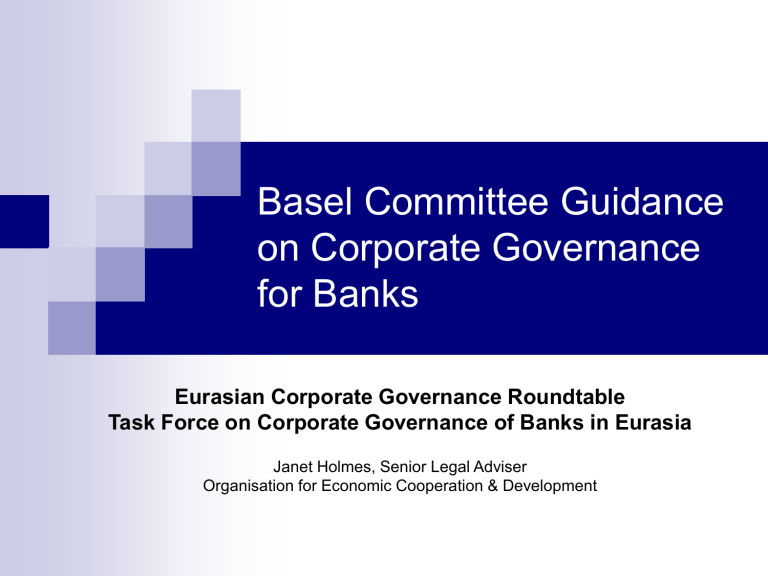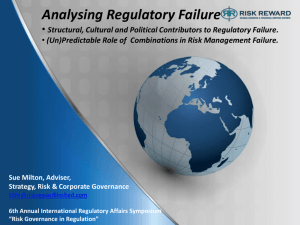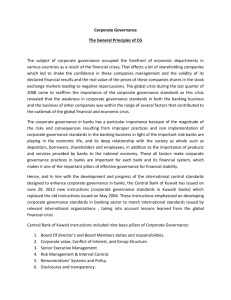Basel Committee Guidance on Corporate Governance for

Basel Committee Guidance on Corporate Governance for Banks
Eurasian Corporate Governance Roundtable
Task Force on Corporate Governance of Banks in Eurasia
Janet Holmes, Senior Legal Adviser
Organisation for Economic Cooperation & Development
Overview of Presentation
Background to Basel Committee guidance paper
Who is responsible for good governance in banks?
Key elements:
Board of directors = oversight
Senior management = internal controls
Supervisors = promote good governance & assess bank practices
This presentation is …
Based on the BCBS guidance, but
The OECD is responsible for the content of these slides
2
Background to Basel Guidance Paper
Enhancing Corporate Governance for Banking Organisations issued in February 2006
Update of 1999 Basel Committee paper
Triggered by revision to OECD Principles in 2004
Complements OECD Principles; not a substitute for them
Reflects lessons learned from recent scandals involving banks
Application
Applies to a wide range of banks and countries
Applies to diverse corporate and board structures
Principles, not rules
Takes into account bank size, complexity and risk profile
Not part of Basel II
Guidance applies regardless of whether a country has adopted the Basel II framework
3
Who is Responsible for Good
Governance in Banks?
Primary responsibility rests with bank boards and senior management (Guidance Paper, s. III)
Bank supervisors have an important role to play by providing guidance & assessing bank practices (Guidance Paper, s. IV)
Others can promote good governance (Guidance Paper, s. V), e.g
.:
Shareholders
Depositors & customers
Employees
Auditors
Banking industry associations
Credit rating agencies
Governments, securities regulators and stock exchanges
4
8 Principles for Bank Boards & Senior
Management
Principle 1: Board qualifications, capabilities and responsibilities
Principle 2: Board’s role regarding the bank’s strategic objectives and corporate values
Principle 3: Lines of responsibility & accountability
Principle 4: Ensuring oversight by senior management
Principle 5: Auditors and internal control functions
Principle 6: Board & key executive compensation
Principle 7: Transparent governance
Principle 8: “Know your operational structure”
5
Principle 1
Board members should be qualified for their positions, have a clear understanding of their role in corporate governance and be able to exercise sound judgment about the affairs of the bank
Some responsibilities apply to any kind of organisation (bank or non-bank), for example:
The board should understand its oversight role
Some responsibilities are unique to the banking sector:
Promote bank safety and soundness
Understand the regulatory environment
Ensure that the bank maintains an effective relationship with supervisors
6
Principle 1 (continued)
Board should have an adequate number of independent members
Independence = ability to exercise objective judgment, independent of
the views of management, political interests, and inappropriate outside interests
7
Principle 2
The board of directors should approve and oversee the bank’s strategic objectives and corporate values that are communicated through the banking organisation
Standards should address, among other things:
Corruption
Self-dealing
Other illegal, unethical or questionable behaviour
Employees should be encouraged to raise concerns about illegal or unethical practices to the board or an independent committee without fear of reprisal or retaliation
8
Principle 2 (continued)
Watch out for practices that could diminish the quality of corporate governance, for example:
Internal lending (to officers, employees, board members or controlling shareholders)
Preferential treatment for related parties and other favoured entities
Conflicts of interest
The board should ensure senior management implements effective policies to prevent (or limit) such activities
9
Principle 3
The board of directors should set and enforce clear lines of responsibility and accountability throughout the organisation
Role of the board:
Define authorities & key responsibilities
Oversee management actions
Senior management’s role:
Delegate to staff & promote accountability
Be responsible to the board for bank’s performance
Guidance also addresses:
Accountability where bank is part of a larger group structure
Outsourcing of bank functions
10
Principle 4
The board should ensure that there is appropriate oversight by senior management consistent with board policy
Senior management should:
Have the necessary skills to manage the business
Oversee line managers consistent with board policies (but avoid “micromanaging” line managers)
Under board’s guidance, establish system of internal controls
Apply the “four eyes” principle, even in small banks
Watch out for senior managers who are unwilling or unable to exercise effective control over “star employees”
11
Principle 5
The board and senior management should effectively utilise the work conducted by the internal audit function, external auditors and internal control functions
Internal audits – the board & senior management should:
Recognise & communicate importance of audit & internal control processes throughout the bank
Use the findings of internal audits and require timely correction of problems by management
Promote the internal auditor’s independence, e.g.
through reporting to the board or board’s audit committee
Engage internal auditors to judge effectiveness of key internal controls
12
Principle 5 (continued)
External audits - the board and senior management should:
Ensure that external auditors comply with applicable codes & standards of professional practice
Ensure that external auditors understand their duties
Engage external auditors to review internal controls relating to financial statements
Encourage the principal auditor to take responsibility for other external audits of financial statements conducted within a group
For state-owned banks, maintain a dialogue as appropriate with state supreme audit institutions, state controllers and external auditors
13
Principle 6
The board should ensure that compensation policies and practices are consistent with the bank’s corporate culture, long-term objectives and strategy, and control environment
Board (or independent committee) should approve compensation, consistent with remuneration policy
Avoid compensation policies that create incentives for excessive risk-taking
Policies should be clear regarding:
Holding and trading of stock in bank or affiliated companies
Granting and repricing of stock options
14
Principle 7
The bank should be governed in a transparent manner
Disclosure should be made on the bank’s website, in its annual/periodic reports and/or in reports to supervisors about:
Board and senior management structure
Basic ownership structure & organisational structure
Incentive structures ( e.g.
remuneration policies)
Code of business conduct and/or ethics code
Bank policies relating to conflicts of interest & related party transactions
State’s ownership policy, if the bank is state-owned
15
Principle 8
The board and senior management should understand the bank’s operational structure, including where the bank operates in jurisdictions, or through structures, that impede transparency (i.e. “know-your-structure”)
Banks sometimes operate in jurisdictions, or employ structures, that lack or impair transparency
This sometimes occur for legitimate business purposes …
But doing so can:
Pose significant financial, legal and reputational risks for bank
Impede board and senior management oversight
Make it more difficult for authorities to effectively supervise the bank
16
Principle 8 (continued)
The risks should be appropriately assessed and managed
Information regarding the activities and risks should be easily available at the bank’s head office & reported to the board and bank’s supervisors
Clear policies and procedures should exist
For board approval of the bank’s use (or sale) of complex structures, instruments and products
For the identification and management of material risks
Regularly evaluate the need to operate in jurisdictions or use structures that reduce transparency
Set clear corporate governance expectations for all relevant entities and business lines
Assess compliance with applicable laws and internal policies
Activities should be subject to enhanced audit procedures and internal control reviews
17
6 Recommendations for Bank
Supervisors
Supervisors should:
Consider corporate governance as one element of depositor protection
Provide guidance to banks on sound corporate governance and proactive practices
Evaluate banks’ implementation of corporate governance policies and practices
Assess the quality of banks’ audit and control functions
Evaluate the effects of the bank’s group structure
Bring to the attention of boards and senior management any problems they detect through supervisory efforts
18
For more information
Go to www.bis.org/BCBS
19



